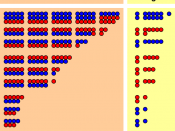Introduction
When Americans vote for a President and Vice President, they are actually voting for presidential electors, known collectively as the Electoral College. It is these electors, chosen by the people, who elect the chief executive. The Constitution assigns each state a number of electors equal to the combined total of the state?s Senate and House of Representatives delegations; at present, the number of electors per state ranges from three to 55, for 538. In each presidential election year, political parties and other groupings in each state, usually at a state party convention, or by the party state committee, nominate a group (ticket or slate) of candidates for elector. It is these elector-candidates, rather than the presidential and vice presidential nominees, for whom the people vote in the November election, which is held on Tuesday after the first Monday in November (November 2, 2004). In most states, voters cast a single vote for the slate of electors pledged to the party presidential and vice presidential candidates of their choice.
Electors assemble in their respective states on Monday after the second Wednesday in December (December 13, 2004). The electoral vote results are counted and declared at a joint session of Congress, held on January 6 of the year succeeding the election. A majority of electoral votes (currently 270 of 538) is required to win. If no candidate receives a majority, then the House of Representatives elect the President, and the Senate, a process known as contingent election, elects the Vice President. (North Harris College Library, 2003)
The Electoral Collage as used today
In practice, this formulation also prohibits any person working for the federal government in either a civilian or a military capacity from serving as an elector. (U.S. Constitution, Article II, Section 1.) (Neal, T.H. 2001)
Under the...

